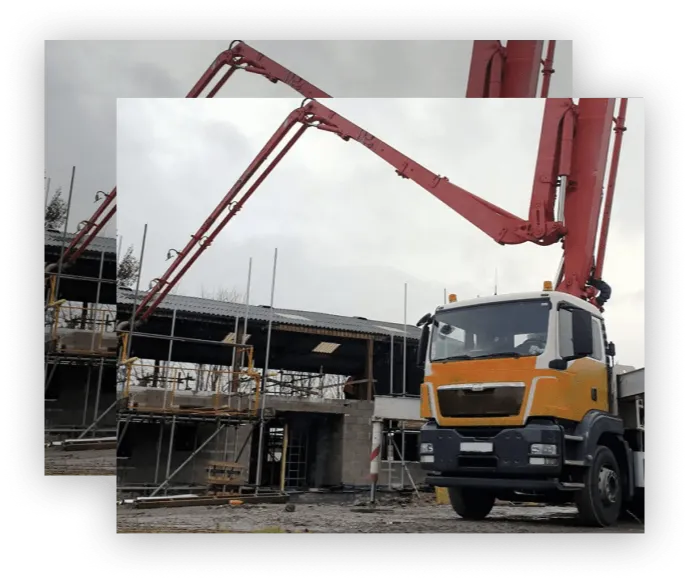Why break a sweat when our experts at Pro-Mix Concrete can pump up your project with our advanced machinery? Our top-tier concrete pump hire service guarantees precise & professional concrete pouring, reaching heights that traditional methods could only imagine. Ideal for contractors working with C15 concrete applications.
At Pro-Mix Concrete, we make the highest-quality ready-mix concrete with optimal strength & durability, perfectly tailored to your project & delivered to your site timely manner. Our ready-mix concrete is the holy grail ingredient to accomplishing your construction tasks impeccably & efficiently.
Get the best concrete mixed to perfection by our team in front of your eyes! Whether you’re pouring a new patio or building complex architectural details, our experts will arrive at your construction site & prepare an ideal C15 concrete mix with premium components & advanced equipment.
With Pro-Mix Concrete’s floor screed, you can create an immaculate foundation to guarantee an even, flawless surface. With our specialists who bring an excellent balance of technical expertise & a dash of whimsical flair, your floors will be the talk of the town!
Remodel your driveway & backyard with Pro-Mix Concrete’s premium-grade domestic concrete! Just like every construction project, our concrete is also unique. We customise the mixture with great attention to meet your specific requirements that promise a long-lasting & even finish.
TYPES OF CONCRETE


C15 Concrete Mix
Pro-Mix Concrete proudly offers the most optimal C15 mix ratio around. This concrete grade C15 finds its utility in various projects, especially for crafting foundations for steps in scenarios where metallic reinforcement within floors is absent. Notably versatile, this concrete variety proves its worth in projects spanning from households to commercial ventures. C15 concrete strength exhibits a sturdy rating of 15N/mm2 after a curing period of 28 days.
What is C15 Concrete Good For?
Our grade C15 mix ratio is perfectly suited for:
-
Floors without embedded metal
-
Small wall foundations, both unreinforced and reinforced strip footings
-
Filling the foundations of trenches
-
Creating foundations for sheds, walls, and conservatories
-
Paving for steps and paths
-
Applying blinding
-
Filling with unreinforced mass concrete
Benefits Of Using C15 Mix
-
C15 concrete is generally less expensive compared to higher-grade concretes, making it ideal for budget-conscious projects.
-
The C15 ratio makes it easy to work with due to its moderate strength. This makes it suitable for applications where intricate shapes or detailed finishes are needed.
-
The specific mix ratio for C15 allows smaller aggregates to be used, resulting in smoother surfaces for finished applications.
-
C15 concrete can set and cure relatively quickly compared to higher-strength concrete mixes. This can expedite the construction process for certain projects.
-
Its lower cement content means less use of this resource-intensive material. That contributes to reduced environmental impact in terms of carbon emissions.
-
The lower-strength concrete can reduce the likelihood of cracking in applications where tensile stresses are minimal.
-
While not suitable for heavy loads, C15 concrete mix can be customised for aesthetic purposes, offering options for coloured or textured finishes.


Get Your C15 Concrete Mix Ratio From Pro-Mix Concrete
We know exactly how C15 material should be made. As one of the most experienced C15 mix suppliers, we understand that it is generally considered to have moderate strength compared to higher-grade concrete. So, we mix it perfectly for applications where load-bearing requirements are moderate and heavy structural demands are not anticipated.
Our production involves carefully blending cement, aggregates (such as sand and gravel), and water in specific proportions according to the optimal C15 material mix ratio. The mixture is then thoroughly mixed to achieve uniformity and poured into the designated formwork. As the concrete cures over time, it gains strength, gradually reaching its intended compressive strength.
Serving the Greater London area, our C15 concrete London delivery service ensures timely and professional supply for all your construction needs. Whether you’re a contractor, renovator, or wholesale buyer, we provide reliable service across London’s diverse construction landscape.
Do you find yourself in need of diverse concrete types and seeking guidance regarding the most fitting mixture? Our proficient team of experts stands ready to assist. A single call can set your project on the right path!
Let Our C15 Concrete Calculator Help You
Our user-friendly C15 concrete mix ratio calculator remains at your disposal to accurately gauge the required quantity for your specific project. This advanced tool ensures that you acquire exactly what you need, minimising waste and maximising efficiency for contractors and renovators alike.
Use Our C15 Mix Ratio Calculator & Get Accurate Estimations in Seconds!
Frequently Asked Questions
People also call the C15 concrete mix ratio by another name, GEN2. C15 concrete works well for floor foundations and creating garden pathways. So, if you’re aiming for an affordable and dependable option for walkways and patios, thinking about concrete grade C15 is a smart move. Yet, remember to ensure quality when searching for cost-effective solutions.
The C15 concrete ratio typically consists of 1 part cement, 2 parts sand (fine aggregate), and 4 parts aggregate (gravel). Additionally, water is added to achieve the desired consistency for pouring and shaping. This concrete C15 mix ratio indicates the proportions in which each component should be combined to create concrete with the specified compressive strength and characteristics.
C15 concrete strength provides excellent durability and a long lifespan, reducing the need for frequent replacements. When raw materials are sourced locally, it reduces transportation emissions. Additionally, concrete is recyclable. Ccrushed concrete can be used as aggregate in new mixes or as base material for roads and pavements.
Yes, for specific applications:
- Shallow Foundations: Perfect for small walls, garden structures, and minor residential projects
- Pathways and Steps: Ideal for surfaces needing stable bases without significant structural loads
- Conservatory Foundations: Suitable for structures without substantial weight requirements
- Blinding Layer: Excellent as a thin layer over prepared ground surfaces
- Minor Structural Components: Ideal for retaining walls with minimal load requirements
Both C10 and C15 mixes serve as suitable options for foundation or footing mixes in cases like non-load bearing walls and garden walls up to 900mm in height. However, C15 concrete strength is higher than C10, making it more suitable for applications requiring additional durability.


